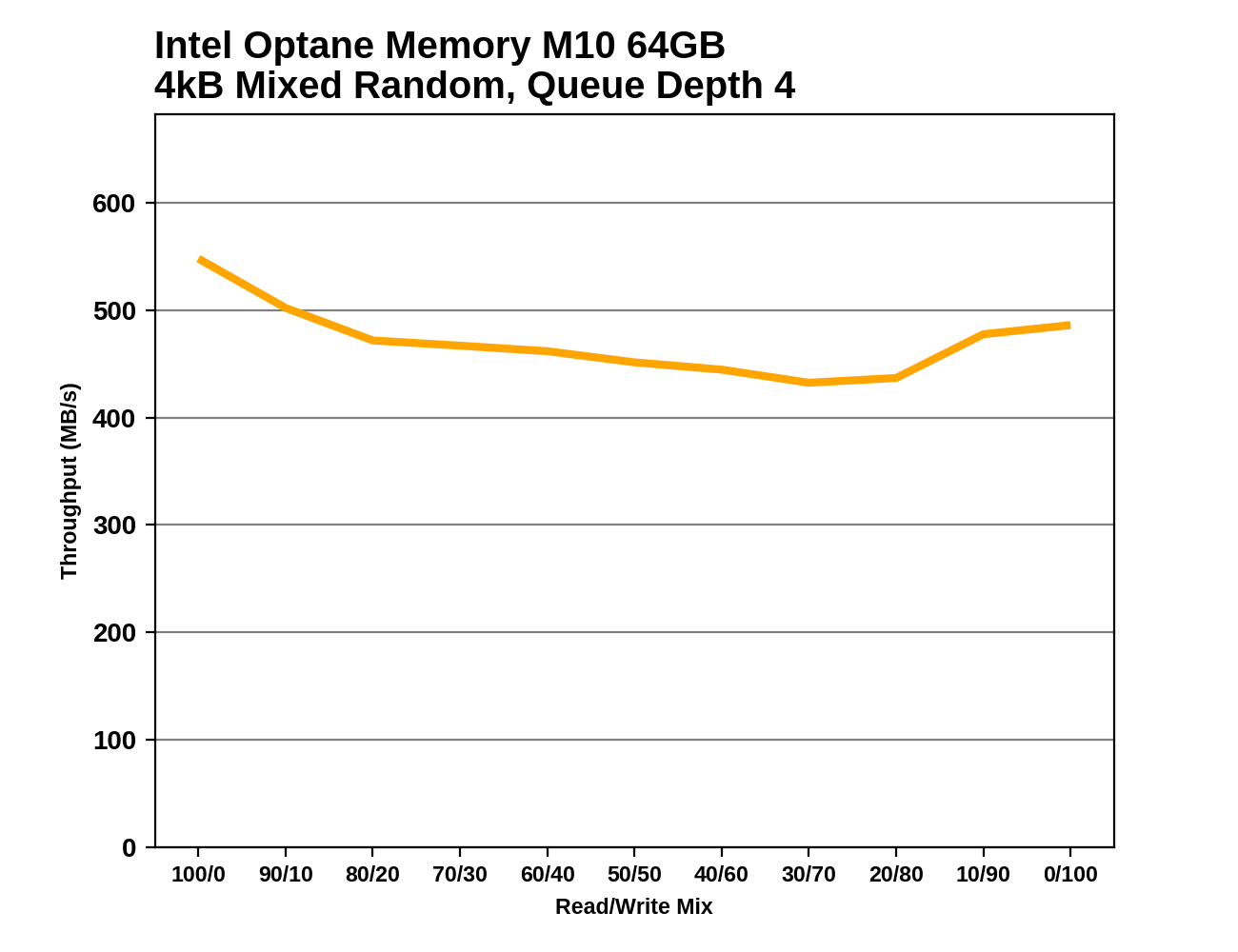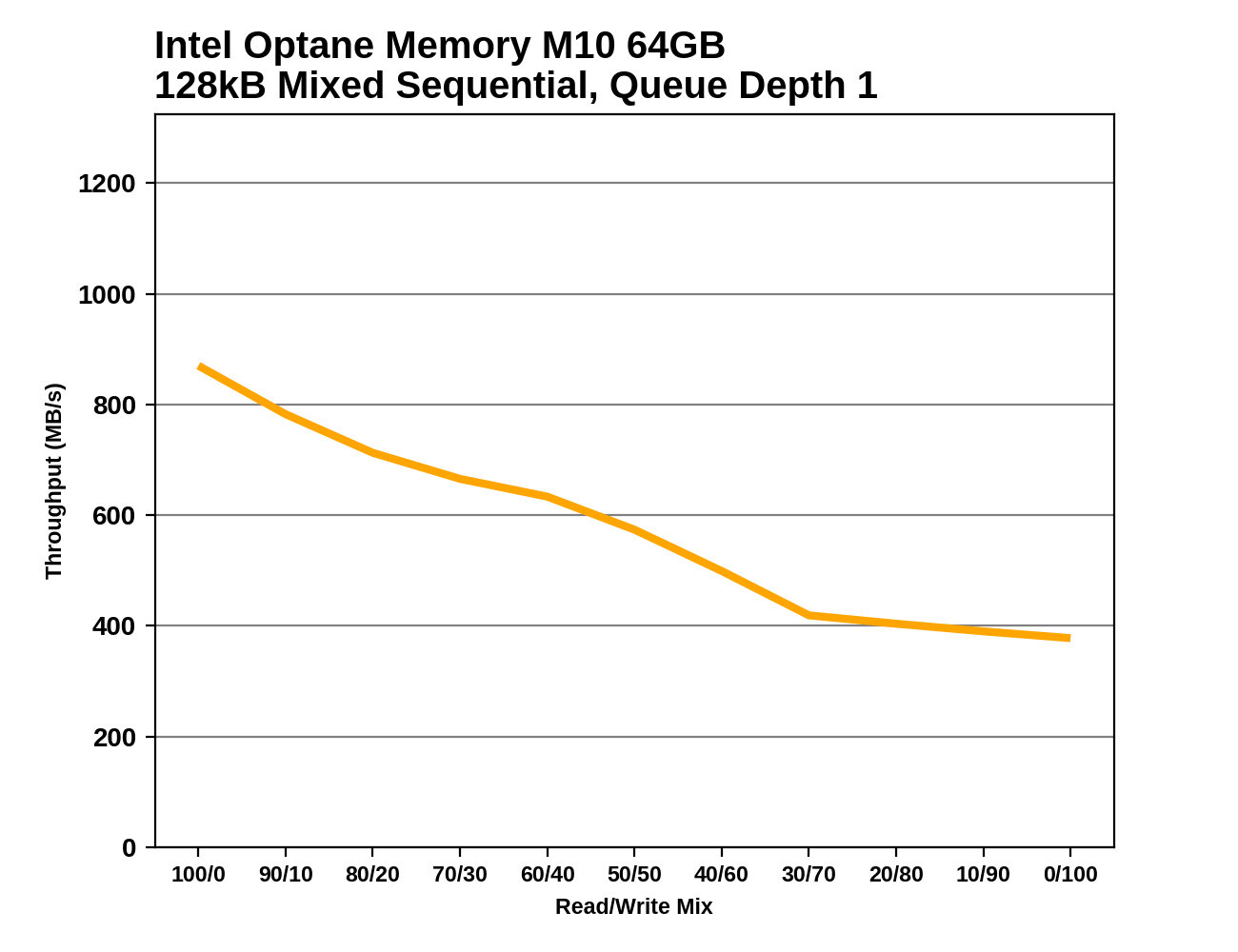The Intel Optane Memory M10 (64GB) Review: Optane Caching Refreshed
by Billy Tallis on May 15, 2018 10:45 AM EST- Posted in
- SSDs
- Storage
- Intel
- PCIe SSD
- SSD Caching
- M.2
- NVMe
- Optane
- Optane Memory
Mixed Random Performance
Our test of mixed random reads and writes covers mixes varying from pure reads to pure writes at 10% increments. Each mix is tested for up to 1 minute or 32GB of data transferred. The test is conducted with a queue depth of 4, and is limited to a 64GB span of the drive. In between each mix, the drive is given idle time of up to one minute so that the overall duty cycle is 50%.

Unsurprisingly, the mixed random I/O test produces crap performance from the hard drive and the two cache configurations where the cache is too small for this test. The 118GB Optane SSD 800P is more cache than this test needs, and it performs almost as well as the Optane SSD 900P.
 |
|||||||||
When used as a cache for this test, the largest Optane SSD 800P shows slightly different performance characteristics than when it is treated as a standalone drive, but in either case it is a strong performer across the board. The smaller Optane drives aren't large enough to cache the entire working set of this test and can't do much to improve performance over the hard drive.
Mixed Sequential Performance
Our test of mixed sequential reads and writes differs from the mixed random I/O test by performing 128kB sequential accesses rather than 4kB accesses at random locations, and the sequential test is conducted at queue depth 1. The range of mixes tested is the same, and the timing and limits on data transfers are also the same as above.

All of the Optane configurations easily outperform the SATA drives on the mixed sequential I/O test. The 64GB and 118GB modules are tied when tested as standalone drives and close when tested as cache devices, and the cache performance is 30-40% faster than the standalone SSD performance. The 32GB module is substantially slower and performance is much closer between caching and standalone SSD use.
 |
|||||||||
The performance improvements in the caching configurations over the standalone drive configurations generally apply throughout the mixed sequential test. The main exception is in the early phases of the test with the 32GB cache, where cache performance falls far short of the standalone drive performance. Once the proportion of reads has dropped to 70%, the cache configuration comes out ahead.










96 Comments
View All Comments
Billy Tallis - Tuesday, May 15, 2018 - link
Yes, but since my AMD system is a Threadripper, it won't actually represent any cost savings compared to the systems tested in this review.evernessince - Wednesday, May 16, 2018 - link
AdoredTV already did a video showing the performance improvements from StoreMi.https://www.youtube.com/watch?v=D3-SqJHYzC0
AMD's solution works in the same way, in that as you run programs it stores data to the cache drive. The big difference is AMD's solution let's you use any SSD as a cache drive. This means it can be any size and it doesn't require an addition purpose. This is especially important, give the huge price tag of the larger optane drives.
Speed wise though, assuming the Intel SSD is actually big enough to cache all your data, they are about equal. Of course, the AMD solution would be slower if you used a really low end SSD as your cache drive. It could also be much faster if you used a really good SSD though. The Intel optane drive has performance numbers similar to a 960 evo. The problem for Intel though are the small sizes and large prices. $200 for only 118GB of space is not a good solution. You could get double that space with a brand new 250GB 960 evo and it costs half as much. That's assuming you want to keep that drive for caching only, you could simply use your current SSD with the AMD solution and save $200+ altogether.
I simply don't see a universe where Optane makes sense.
CheapSushi - Wednesday, May 16, 2018 - link
You realize you can use Optane like any other SSD right? You can even use it with StorageMI.MDD1963 - Tuesday, May 15, 2018 - link
There will be no tiny Optane things inserted into/wasting an M.2 NVME slot making it SEEM like I have a 960/970; there will be a 960/970. :)Valantar - Tuesday, May 15, 2018 - link
Any chance you could test one of these drives with AMD's new caching solution? AFAIK the drives show up as regular NVME devices, so it should work in theory. Would be really interesting to see these solutions compared, and if Ryzen or Threadripper can make proper use of Optane caching through third-party software.Billy Tallis - Tuesday, May 15, 2018 - link
I'll be setting up a Threadripper system this week to test both caching and NVMe RAID.Lolimaster - Tuesday, May 15, 2018 - link
My only use for an optane drive would be for swap file, firefox/chrome cache/install/profiles and GTA5.But a 500GB 860EVO cost $169 with 300TB of endurance vs 365TB on optane, with the 860 offering 4x the storage... dunno.
Their "low end" 118GB 800p needs to improve endurance to at least 1PB level to be a proper swapfile/browser/cache tool
evernessince - Wednesday, May 16, 2018 - link
So what's the point of this when AMD is giving away StoreMi with it's X470 boards? From what I've seen from reviews of the product, it works exceptionally well. It also doesn't require you to buy another drive and it can use much larger SSDs as a cache.CheapSushi - Wednesday, May 16, 2018 - link
You can definitely ignore Intel's marketing pitch about these. But you can use ANY Optane drive, including ones mentioned here like ANY OTHER SSD out there. So you can make it work with StoreMi too. You have to decide which drive benefits your workload more and how and what your budget is. Optane has inherent benefits that beats out NAND is many ways. But again, just depends on what you want. The smaller GB ones are pretty damn cheap in my opinion. So worth just trying out.Svend Tveskæg - Wednesday, May 16, 2018 - link
Reminds me of back in the days, when you could buy a weird plastic screen, that claimed it would turn your black and white television into a color-TV....